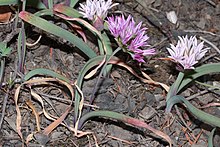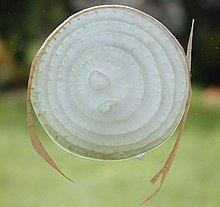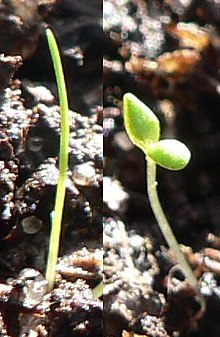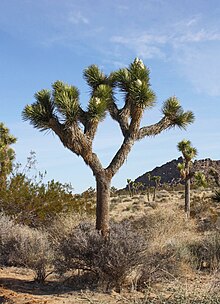
A | B | C | D | E | F | G | H | CH | I | J | K | L | M | N | O | P | Q | R | S | T | U | V | W | X | Y | Z | 0 | 1 | 2 | 3 | 4 | 5 | 6 | 7 | 8 | 9
| Monocotyledons Temporal range:
| |
|---|---|
| Diversity of monocots which includes wheat (Triticum), taro (Colocasia esculenta), date palm, (Phoenix dactylifera), Zostera marina, lily (Lilium), Pandanus heterocarpus, and ginger (Zingiber officinale) | |
| Scientific classification | |
| Kingdom: | Plantae |
| Clade: | Tracheophytes |
| Clade: | Angiosperms |
| Clade: | Monocots |
| Type genus | |
| Lilium | |
| Orders | |
| Synonyms | |
Monocotyledons (/ˌmɒnəˌkɒtəˈliːdənz/),[d][13][14] commonly referred to as monocots, (Lilianae sensu Chase & Reveal) are grass and grass-like flowering plants (angiosperms), the seeds of which typically contain only one embryonic leaf, or cotyledon. They constitute one of the major groups into which the flowering plants have traditionally been divided; the rest of the flowering plants have two cotyledons and are classified as dicotyledons, or dicots.
Monocotyledons have almost always been recognized as a group, but with various taxonomic ranks and under several different names. The APG III system of 2009 recognises a clade called "monocots" but does not assign it to a taxonomic rank.
The monocotyledons include about 70,000 species, about a quarter of all angiosperms. The largest family in this group (and in the flowering plants as a whole) by number of species are the orchids (family Orchidaceae), with more than 20,000 species. About 12,000 species belong to the true grasses (Poaceae), which are economically the most important family of monocotyledons. Often mistaken for grasses, sedges are also monocots.
In agriculture the majority of the biomass produced comes from monocotyledons. These include not only major grains (rice, wheat, maize, etc.), but also forage grasses, sugar cane, the bamboos, and many other common food and decorative crops.
Description


General
The monocots or monocotyledons have, as the name implies, a single (mono-) cotyledon, or embryonic leaf, in their seeds. Historically, this feature was used to contrast the monocots with the dicotyledons or dicots which typically have two cotyledons; however, modern research has shown that the dicots are not a natural group, and the term can only be used to indicate all angiosperms that are not monocots and is used in that respect here. From a diagnostic point of view the number of cotyledons is neither a particularly useful characteristic (as they are only present for a very short period in a plant's life), nor is it completely reliable. The single cotyledon is only one of a number of modifications of the body plan of the ancestral monocotyledons, whose adaptive advantages are poorly understood, but may have been related to adaption to aquatic habitats, prior to radiation to terrestrial habitats. Nevertheless, monocots are sufficiently distinctive that there has rarely been disagreement as to membership of this group, despite considerable diversity in terms of external morphology.[15] However, morphological features that reliably characterise major clades are rare.[16]
Thus monocots are distinguishable from other angiosperms both in terms of their uniformity and diversity. On the one hand, the organization of the shoots, leaf structure, and floral configuration are more uniform than in the remaining angiosperms, yet within these constraints a wealth of diversity exists, indicating a high degree of evolutionary success.[17] Monocot diversity includes perennial geophytes such as ornamental flowers including orchids (Asparagales); tulips and lilies (Liliales); rosette and succulent epiphytes (Asparagales); mycoheterotrophs (Liliales, Dioscoreales, Pandanales), all in the lilioid monocots; major cereal grains (maize, rice, barley, rye, oats, millet, sorghum and wheat) in the grass family; and forage grasses (Poales) as well as woody tree-like palm trees (Arecales), bamboo, reeds and bromeliads (Poales), bananas and ginger (Zingiberales) in the commelinid monocots, as well as both emergent (Poales, Acorales) and aroids, as well as floating or submerged aquatic plants such as seagrass (Alismatales).[18][19][20][21]
Vegetative
Organisation, growth and life forms
The most important distinction is their growth pattern, lacking a lateral meristem (cambium) that allows for continual growth in diameter with height (secondary growth), and therefore this characteristic is a basic limitation in shoot construction. Although largely herbaceous, some arboraceous monocots reach great height, length and mass. The latter include agaves, palms, pandans, and bamboos.[22][23] This creates challenges in water transport that monocots deal with in various ways. Some, such as species of Yucca, develop anomalous secondary growth, while palm trees utilise an anomalous primary growth form described as establishment growth (see Vascular system). The axis undergoes primary thickening, that progresses from internode to internode, resulting in a typical inverted conical shape of the basal primary axis (see Tillich, Figure 1). The limited conductivity also contributes to limited branching of the stems. Despite these limitations a wide variety of adaptive growth forms has resulted (Tillich, Figure 2) from epiphytic orchids (Asparagales) and bromeliads (Poales) to submarine Alismatales (including the reduced Lemnoideae) and mycotrophic Burmanniaceae (Dioscreales) and Triuridaceae (Pandanales). Other forms of adaptation include the climbing vines of Araceae (Alismatales) which use negative phototropism (skototropism) to locate host trees (i.e. the darkest area),[24] while some palms such as Calamus manan (Arecales) produce the longest shoots in the plant kingdom, up to 185 m long.[25] Other monocots, particularly Poales, have adopted a therophyte life form.[26][27][28][29][30]
Leaves
The cotyledon, the primordial Angiosperm leaf consists of a proximal leaf base or hypophyll and a distal hyperphyll. In monocots the hypophyll tends to be the dominant part in contrast to other angiosperms. From these, considerable diversity arises. Mature monocot leaves are generally narrow and linear, forming a sheathing around the stem at its base, although there are many exceptions. Leaf venation is of the striate type, mainly arcuate-striate or longitudinally striate (parallel), less often palmate-striate or pinnate-striate with the leaf veins emerging at the leaf base and then running together at the apices. There is usually only one leaf per node because the leaf base encompasses more than half the circumference.[31] The evolution of this monocot characteristic has been attributed to developmental differences in early zonal differentiation rather than meristem activity (leaf base theory).[15][16][32]
Roots and underground organs
The lack of cambium in the primary root limits its ability to grow sufficiently to maintain the plant. This necessitates early development of roots derived from the shoot (adventitious roots). In addition to roots, monocots develop runners and rhizomes, which are creeping shoots. Runners serve vegetative propagation, have elongated internodes, run on or just below the surface of the soil and in most case bear scale leaves. Rhizomes frequently have an additional storage function and rhizome producing plants are considered geophytes (Tillich, Figure 11). Other geophytes develop bulbs, a short axial body bearing leaves whose bases store food. Additional outer non-storage leaves may form a protective function (Tillich, Figure 12). Other storage organs may be tubers or corms, swollen axes. Tubers may form at the end of underground runners and persist. Corms are short lived vertical shoots with terminal inflorescences and shrivel once flowering has occurred. However, intermediate forms may occur such as in Crocosmia (Asparagales). Some monocots may also produce shoots that grow directly down into the soil, these are geophilous shoots (Tillich, Figure 11) that help overcome the limited trunk stability of large woody monocots.[33][32][34][15]
Reproductive
Flowers
In nearly all cases the perigone consists of two alternating trimerous whorls of tepals, being homochlamydeous, without differentiation between calyx and corolla. In zoophilous (pollinated by animals) taxa, both whorls are corolline (petal-like). Anthesis (the period of flower opening) is usually fugacious (short lived). Some of the more persistent perigones demonstrate thermonastic opening and closing (responsive to changes in temperature). About two thirds of monocots are zoophilous, predominantly by insects. These plants need to advertise to pollinators and do so by way of phaneranthous (showy) flowers. Such optical signalling is usually a function of the tepal whorls but may also be provided by semaphylls (other structures such as filaments, staminodes or stylodia which have become modified to attract pollinators). However, some monocot plants may have aphananthous (inconspicuous) flowers and still be pollinated by animals. In these the plants rely either on chemical attraction or other structures such as coloured bracts fulfill the role of optical attraction. In some phaneranthous plants such structures may reinforce floral structures. The production of fragrances for olfactory signalling are common in monocots. The perigone also functions as a landing platform for pollinating insects. [17]
Fruit and seed
The embryo consists of a single cotyledon, usually with two vascular bundles.[32]
Comparison with dicots


The traditionally listed differences between monocots and dicots are as follows. This is a broad sketch only, not invariably applicable, as there are a number of exceptions. The differences indicated are more true for monocots versus eudicots.[34][35][36]
| Feature | In monocots | In dicots |
|---|---|---|
| Growth form | Mostly herbaceous, occasionally arboraceous | Herbaceous or arboraceous |
| Leaves[16] | Leaf shape oblong or linear, often sheathed at base, petiole seldom developed, stipules absent. Major leaf veins usually parallel | Broad, seldom sheathed, petiole common often with stipules. Veins usually reticulate (pinnate or palmate) |
| Roots | Primary root of short duration, replaced by adventitial roots forming fibrous or fleshy root systems | Develops from the radicle. Primary root often persists forming strong taproot and secondary roots |
| Plant stem: Vascular bundles | Numerous scattered bundles in ground parenchyma, cambium rarely present, no differentiation between cortical and stelar regions | Ring of primary bundles with cambium, differentiated into cortex and stele (eustelic) |
| Flowers | Parts in threes (trimerous) or multiples of three (e.g. 3, 6 or 9 petals) | Fours (tetramerous) or fives (pentamerous) |
| Pollen: Number of apertures (furrows or pores) | Monocolpate (single aperture or colpus) | Tricolpate (three) |
| Embryo: Number of cotyledons (leaves in the seed) | One, endosperm frequently present in seed | Two, endosperm present or absent |
A number of these differences are not unique to the monocots, and, while still useful, no one single feature will infallibly identify a plant as a monocot.[35] For example, trimerous flowers and monosulcate pollen are also found in magnoliids,[34] and exclusively adventitious roots are found in some of the Piperaceae.[34] Similarly, at least one of these traits, parallel leaf veins, is far from universal among the monocots. Broad leaves and reticulate leaf veins, features typical of dicots, are found in a wide variety of monocot families: for example, Trillium, Smilax (greenbriar), Pogonia (an orchid), and the Dioscoreales (yams).[34] Potamogeton and Paris quadrifolia (herb-paris) are examples of monocots with tetramerous flowers. Other plants exhibit a mixture of characteristics. Nymphaeaceae (water lilies) have reticulate veins, a single cotyledon, adventitious roots, and a monocot-like vascular bundle. These examples reflect their shared ancestry.[35] Nevertheless, this list of traits is generally valid, especially when contrasting monocots with eudicots, rather than non-monocot flowering plants in general.[34]
Apomorphies
Monocot apomorphies (characteristics derived during radiation rather than inherited from an ancestral form) include herbaceous habit, leaves with parallel venation and sheathed base, an embryo with a single cotyledon, an atactostele, numerous adventitious roots, sympodial growth, and trimerous (3 parts per whorl) flowers that are pentacyclic (5 whorled) with 3 sepals, 3 petals, 2 whorls of 3 stamens each, and 3 carpels. In contrast, monosulcate pollen is considered an ancestral trait, probably plesiomorphic.[36]
Synapomorphies
The distinctive features of the monocots have contributed to the relative taxonomic stability of the group. Douglas E. Soltis and others[37][38][39][40] identify thirteen synapomorphies (shared characteristics that unite monophyletic groups of taxa);
- Calcium oxalate raphides
- Absence of vessels in leaves
- Monocotyledonous anther wall formation*
- Successive microsporogenesis
- Syncarpous gynoecium
- Parietal placentation
- Monocotyledonous seedling
- Persistent radicle
- Haustorial cotyledon tip[41]
- Open cotyledon sheath
- Steroidal saponins*
- Fly pollination*
- Diffuse vascular bundles and absence of secondary growth[f]
Vascular system

Monocots have a distinctive arrangement of vascular tissue known as an atactostele in which the vascular tissue is scattered rather than arranged in concentric rings. Collenchyma is absent in monocot stems, roots and leaves. Many monocots are herbaceous and do not have the ability to increase the width of a stem (secondary growth) via the same kind of vascular cambium found in non-monocot woody plants.[34] However, some monocots do have secondary growth; because this does not arise from a single vascular cambium producing xylem inwards and phloem outwards, it is termed "anomalous secondary growth".[42] Examples of large monocots which either exhibit secondary growth, or can reach large sizes without it, are palms (Arecaceae), screwpines (Pandanaceae), bananas (Musaceae), Yucca, Aloe, Dracaena, and Cordyline.[34]
Zdroj:https://en.wikipedia.org?pojem=MonocotyledonsText je dostupný za podmienok Creative Commons Attribution/Share-Alike License 3.0 Unported; prípadne za ďalších podmienok. Podrobnejšie informácie nájdete na stránke Podmienky použitia.
Antropológia
Aplikované vedy
Bibliometria
Dejiny vedy
Encyklopédie
Filozofia vedy
Forenzné vedy
Humanitné vedy
Knižničná veda
Kryogenika
Kryptológia
Kulturológia
Literárna veda
Medzidisciplinárne oblasti
Metódy kvantitatívnej analýzy
Metavedy
Metodika
Text je dostupný za podmienok Creative
Commons Attribution/Share-Alike License 3.0 Unported; prípadne za ďalších
podmienok.
Podrobnejšie informácie nájdete na stránke Podmienky
použitia.
www.astronomia.sk | www.biologia.sk | www.botanika.sk | www.dejiny.sk | www.economy.sk | www.elektrotechnika.sk | www.estetika.sk | www.farmakologia.sk | www.filozofia.sk | Fyzika | www.futurologia.sk | www.genetika.sk | www.chemia.sk | www.lingvistika.sk | www.politologia.sk | www.psychologia.sk | www.sexuologia.sk | www.sociologia.sk | www.veda.sk I www.zoologia.sk








